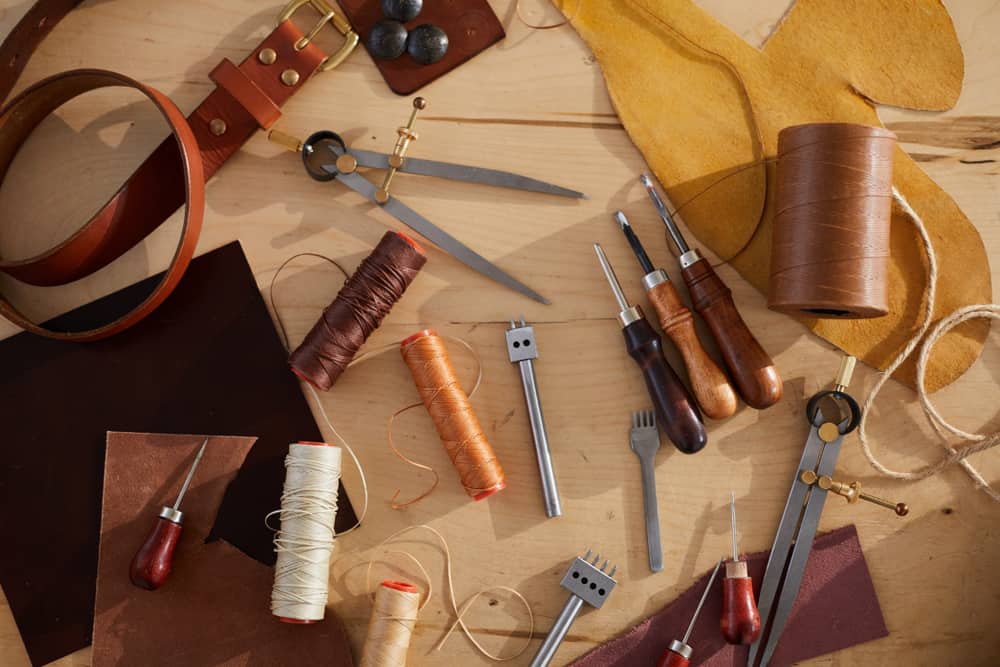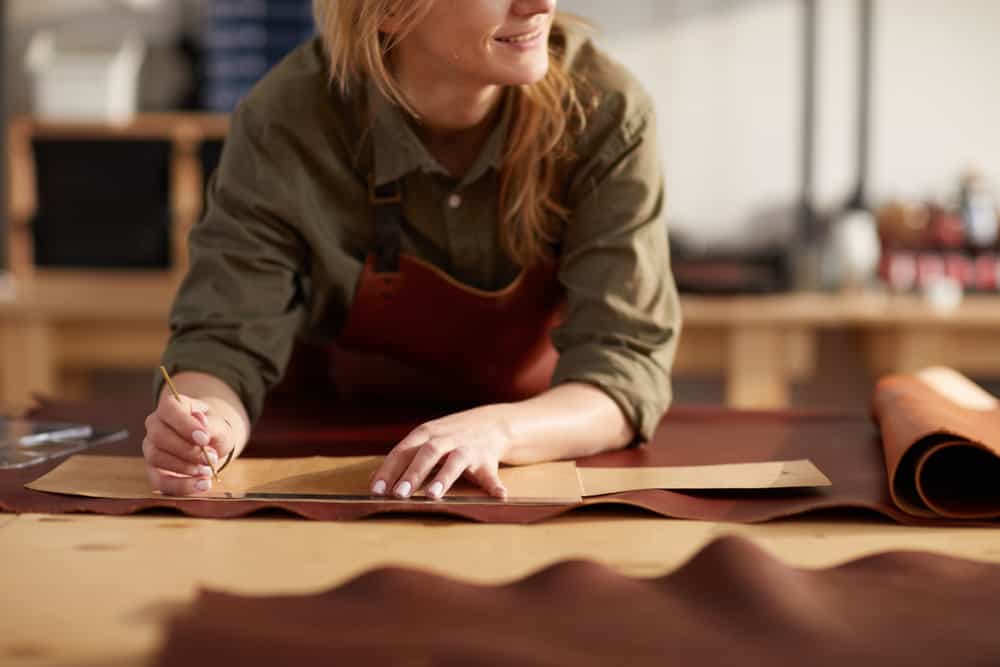Leatherworking
Leatherwork can be a lot of fun, and you can make beautiful and versatile products that can be used every day. The first thought that most people have when they consider taking on leatherwork as a hobby is that it will be difficult and too expensive. This doesn’t have to be the case. Leatherwork is a wonderful creative hobby, and by knowing all the basic tools and products you need to start, it does not have to dig too deep into your pocket.
Leatherwork can cost $20.00 – $5 000.00. The cost depends on both the quantity and quality of the leather and tools you purchase and the projects you choose to make. Reduce expenses by purchasing the basic tools needed, the right leather to use, and by starting with a basic pattern.
Let’s discuss the basic tools and the correct leather required to begin leatherworking and information that can help you learn this new skill and how to keep the costs down.
What Do I Need To Start Leatherwork And What Will My Expenses Be?
For your first leatherwork project, choose something to make that interests you and that is not too difficult to start with. This will keep you invested and passionate about your project.
Decide on something small that won’t take too much time, and that won’t use a lot of leather.
Here are some examples:
- A slim, simple wallet/cardholder
- A simple leather belt
- A journal cover
- A bracelet
- A dog collar
When deciding on the tools, leather, and any other leathercraft items that you may need, it is good to look at whether quality vs. quantity is more important to you.
This is especially applicable for when you are just starting your leatherworking journey, as you may want to practice first before deciding on whether or not this is something that you will enjoy and if it is worth it to invest your time and finances into.
Do I Need A Template To Work From?
Having a template will help guide you in the making of your first project.
Choose a template for a design that you would like to try, or you can make your own template from something that you own.
You can find templates from many websites on the internet and even on Pinterest. Many templates for leatherworking are available for free, or you could make your own digital templates if you have the know-how.
When making your template, you can use cardstock paper or non-corrugated cardboard such as the cardboard from packaging or a cereal box.
What Are Some Basic Skills I Should Know?
When you decide to begin leatherworking, there are a few basic skills that are very important to know how to do before attempting your project.
Skills such as saddle stitching, cutting, and edge finishing are all important skills that must be practiced before attempting a finished piece.
These are some of the skills that will be used in most projects, so try to choose one that includes these basic skills. There are more advanced skills that you can learn as you start new projects.

What Tools Do I Need To Get Started?
The tools you will be using will be a once-off purchase, depending on the quality of the tools that you buy.
At first, you may not be interested in, or have a budget big enough for, spending a large amount of money on good quality leather tools. If you are just trying out leatherwork, then the low-budget tools may make sense for your first purchases, and as you get into leatherwork, you can save up for the good quality tools.
If you do not want to outlay a large amount of money to get started, then you may be able to find most of the tools you will need around the house or at your nearest hardware store.
Starting this way, you can expect to spend below $100 on the tools needed for a project.
Here is an idea of the costs:
- Low-quality tools cost up to $50.00.
- Medium range quality tools cost $50.00 to $100.00.
- High-quality tools cost over $100.00.
The preference is yours whether you would like to purchase the tools individually, or alternatively, you can buy a beginner’s leatherworking kit, which will come with a variety of basic tools that you will need to get started.
The most basic tools you will need include: a knife, glue, needle and thread, diamond chisels, a hammer, and a ruler. Here is more information on the tools:
- Round knife for skiving and cutting. This tool can cost around $80.00. If you would prefer a tool that is a bit cheaper and if you are not sure you will stick with leatherwork, then you can use a rotary cutter instead; the estimated price is $10.00.
- Diamond Chisels for punching stitching holes. There is a range of hole sizes and widths. The estimated price is $55.00.
- Stitching Needles have an estimated cost of $10.00.
- A synthetic thread that will not biodegrade over time.
- Rubber Hammer to keep your other tools in good shape. Estimated price $10.00.
Other basic tools that can be purchased for specific projects as you go may include Edge Bevelers, Groover and Creaser, Stitching Awl, Edge Burnisher, Stitching Horse, Punches, Rivet Setters, and Cutting Board. As well as glue and leather dye.
Leather dye doesn’t need to be used on finished leather, but it can be used on the edges to complete the look of your project. If you do not want to purchase a dye, you can make one from coffee or tea at home.
The best glue that can be used is a non-water based contact cement. The glue will help keep the seams and joints together.
What Leather Would I Need?
When starting with leatherwork, the highest cost over a long period of time will be your leather as you need this for every project that you make.
The leather will become more expensive when looking for specific characteristics such as color, size, thickness, texture, temper, finish, and blemish. There are many different local stores and online stores where you can purchase your leather.
What are the expected costs of leather?
- Low-quality leather is up to $5.00 per square foot.
- Medium range quality leather is between $12.00 and $15.00 per square foot.
- High-quality leather is between $18.00 and $30.00 per square foot.
Each piece of leather you buy is unique as it is an organic material, and it comes from many different animals, and different tanneries use unique processes to create their leather.
The variety of different leathers are intriguing to a leatherworker but can also be overwhelming if you don’t understand what leather is used when.
When starting, the most important thing to consider when deciding on the type of leather to buy is cost and consistency. You don’t want to make mistakes on expensive leather.
The consistency of the leather you choose is important when learning. This will help you focus on your skill, which is vital to improving when starting by eliminating as many variables that may cause mistakes.
When deciding on what leather you will need to use, it is good to know what you will need to look for to do your project, including the tannage, weight, temper, and finish.
There are two types of tanning processes the one is vegetable tanned leather, which uses vegetable oil, and the other is chrome tanned leather, where chemicals are used.
Chrome tanned leather is thinner, stretchy, and less durable. This is less expensive than vegetable-tanned leather and the kind of leather you would see on car seats.
Vegetable-tanned leather is thicker, firmer, and more durable. This is more expensive than chrome leather and the kind of leather you would see on leather shoes.
When starting, it would be recommended to use vegetable tanned leather, although it will depend on what you choose as your first project.
The weight or thickness of the piece of leather that you will need will depend on the project you will be doing.
Start with one type of leather to practice your techniques and to build your confidence.
Conclusion
Leatherwork isn’t something to be nervous about starting; as you have seen above, you can start at a basic level that is not too expensive, and there are a few techniques that can help you get started.
Once you improve your skill and start making more products more quickly, you can start thinking of selling the products you make, which can reduce your costs.
Have fun with making leather crafts and get your creativity going. Turn on your creativity and dream up those spectacular leather projects you have been dying to make!
